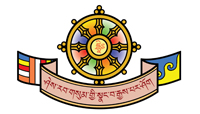35. 9th Situpa 1774 - 1853
|
“From the palace of the dharmakaya of unchanging truth, Lord Padma Nyingche, I supplicate you.” -- “Supplication and Offerings to the Kagyü Gurus”
The Ninth Kenting Tai Situpa, Pema Nyinche Wangpo was born in the wood-horse year in Yilung that is situated near Derge in East Tibet. The Thirteenth Gyalwa Karmapa, Düdul Dorje, together with Pawo Tsuglag Gawa (who had received a prediction from Guru Padmasambhava in a vision concerning Tai Situpa’s rebirth) recognized Pema Nyingche as the reincarnation of the Eighth Situ Rinpoche. At the age of 8, Pema Nyingche was enthroned with the Red Vajra Crown as the Ninth Tai Situpa. Pawo Tsuglag Gawa then wrote the long-life prayer for him, which is entitled “The Incarnation of the Compassion of all Buddhas (rgyal ba yongs kyi), the prayer for the long life of Pema Nyingche.”
Pema Nyingche studied and practiced under the guidance of many masters, especially under the tutelage of his two principal teachers, the Thirteenth Karmapa and the Tenth Shamar. He also studied with Dzingar Dorje Trakpa and many other accomplished masters. He became a great scholar and meditation master and his Dharma activities flourished throughout the lands. His collected writings consist of two hundred treatises. They are available under the title “H.E. the 9th Situpa Pema Nyinjed's Collected Works” to students of Karma Lekshey Ling Institute in the link “Great Masters’ Collected Works.”
The Ninth Tai Situpa recognized and became the Root Guru of the Fourteenth Gyalwa Karmapa, Thegchog Dorje, of Jamgon Kongtrul Lodrö Thaye the Great, of Dzongsar Khyentse Wangpo Rinpoche and Chögyur Lingpa, also known as Chokling Dechen Lingpa, whose work "’Lamrim Yeshe Nyingpo’ - Commentary by Jamgon Lodrö Thaye (lam rim ye shes snying po las bskyed rim gyi skor) Terton Chokgyur Lingpa” is also available to students in the link “Buddhist Philosophy Texts” of this website. Tai Situpa gave his closest heart-sons the full Kamtsang Lineage transmissions and instructions and they all became leading figures in both the Nyingma and Kagyü Traditions. According to the Tibetan Buddhist Resource Center, his other close disciples were Khenchen Tashi Özer, Mingyur Wangyal, Dazang Ngedon Tenpa Rabgye, Karma Sangye Chöpel, Jigme Pälgyi Senge, and Konchog Jigme Namgyal. Tai Situpa also established many retreat centers, made innumerable offerings to monasteries of all traditions, and renovated the great monastery at Palpung, where he taught and inspired many devotees to practice diligently and to teach the meditation practices of the pure Kagyü Lineage to others.
Pema Nyingche Wangpo started what has become known as Rime that became firmly established by his disciples. In the introduction to “The Treasury of Knowledge – Esoteric Instructions” we read that Jamgon Kongtrul Lodrö Thaye “did not seem to define it (Rime) anywhere, and certainly not as a well-formulated political stance. Rather, it seems to be a somewhat ordinary expression that Kongtrul used so much that it became a kind of catchword for his attitude. Ris means ‘part,’ or ‘region,’ and med is a negation. It is a contraction of ris su med pa, ‘not in parts,’ the opposite of ris su chad pa, ‘cut in parts,’ and a synonym of phogs med, ‘without directions.’ In other words, it means ‘whole, entire, intact,’ and in usage could be translated as ‘unlimited’ or ‘without regard for categories.’”
In “The Song of Thekchok Dorje,” the Fourteenth Gyalwa Karmapa described his Root Guru in the following praise that he composed:
“NAMO GURAVE The embodiment of the refuge jewels, the lord of dharma, Vajradhara, soverign of all the families, The glorious great bliss in human form, Is known as Lord Padma Nyingche Wangpo.”
Jamgon Kongtrul Rinpoche praised and honored his Root Guru in the very best way on many occasions, such as with the following verses of “The Song of Lodrö Thaye,” in which he refers to him as Padma Wangchen or simply Padma:
“The illustrious one, Vajradhara, Who is said to possess the eight good qualities, Is seen in human form by ordinary men like us. You are the refuge called Padma, endowed with blessings. From the eight-petaled lotus dome of my heart, I supplicate you not to be separate even for an instant. (…)
“In this way, from the great lords of yogins, Naropa and Maitripa, Down to the lord guru Padma Wangchen, The golden garland of the Kagyüs Reached the dharmakaya kingdom of nonmeditation, Spontaneously cleared away the darkness of the two obscurations, Expanded the great power of the two knowledges, Opened the treasury of benefit for the sake of others pervading space, And remained in the refuge of mind free from doubt.”
The song of realization that Pema Nyingche Wangpo composed, entitled “The Song of Padma Nyingche,” is also published in “The Rain of Wisdom.” A few verses are:
“NAMO GURU-PADMAKARAYA Glorious lord of all families, bhagavat, Your body possesses the seven aspects of supreme union And you manifest as Vajradhara in person. I pay homage at the feet of Lord Düdul Dorje. (…)
“Worthy ones meet the body mandala of the guru who is the Lord Buddha in person, Receive the amrita of his speech, And receive the blessings of the vajra wisdom of his mind. This makes the worthy ones even more fortunate. (…)
“All worthy ones endowed with faith, exertion, and prajna And with a mind of devotion, revulsion, and renunciation, Through their immeasurable friendliness and compassion Establish all sentient beings pervading space In complete liberation, And keep this practice in the state of nonconception.
“At this time when I have complete freedom, May I keep to retreat, turning my mind from the eight worldly dharmas. I should hold dear this samaya and abandon entertainment. By sowing the seeds of practice, At the time when one’s composite body falls apart, One attains the sambhogakaya of great bliss In the vast pervasive space of dharmadhatu. Free from obstruction, one is able to manifest many emanations, This is the great kindness of the blessings of the profound dharma.
“By the powerful wind of fierce karma and kleshas Like endlessly undulating waves, One circles again in samsara through the force of ego-fixation. One is never cleared of the magical illusions of mind.”
In the last verses of this song, he supplicated his Guru, the Thirteenth Gyalwa Karmapa, with sincerest longing:
“Although the kindness of the lord victorious ones is never untimely, Since the troops of the four maras oppress me In this prison of the gain and esteem of fixation on permanence, Please manifest the light of your supreme blessings.
“When the kleshas control my body, speech, and mind, Grant your blessings so that the antidote may be effective in my being. Grant your blessings so that all auspiciousness may coincide in my body. Grant your blessings so that experience and realization may arise in my mind. Grant your blessings so that I may impartially benefit beings. Grant your blessings so that the virtues of the paths and bhumis may increase. Grant your blessings so that I may attain enlightenment in one lifetime. Grant your blessings so that I may hold the royal seat of the four kayas. Grant your blessings so that I may spontaneously accomplish whatever mind desires.”
At the age of 61, Pema Nyingche Wangpo, “Lotus, Powerful Sun,” entered the retreat centre Drubgyu Samten Ling at Palpung Chökhor Ling Monastery and stayed in meditation until the end of his life. Many rainbows appeared in the sky and other auspicious signs manifested when, at the age of 79, he entered Parinirvana on the seventh of the fifth lunar month in the year 1853.
References: “The Rain of Wisdom. The Vajra Songs of the Kagyü Gurus,” transl. under the direction of Chögyam Trungpa by the Nalanda Translation Com., Boston & London, 1980, pages 72-75, 76, 81, & 88-89. Jamgon Kongtrul Lodrö Thaye, “Jamgon Kongtrul’s Retreat Manual,” transl. & intr. by Ngawang Zangpo, Tsadra Foundation, N.Y. & Colorado, 1994, pages 131, 191, & 202. Jamgon Kongtrul Lodrö Thaye, “The Treasury of Knowledge – Book Eight, Part Four: Esoteric Instructions,” translated & annotated by Sarah Harding from the Kalu Rinpoche Translation Group under the direction of Venerable Bokar Rinpoche, Ithaca, N.Y., 2007, page 35. Simhanada, “The 9 th Tai Situ Pema Nyingjey Wangpo” (2008).
May this short life-story strengthen our wish to increase our knowledge and goodliness!
(With sincere gratitude to Khenpo Karma Namgyal for his immense generosity, compiled & written for English-speaking visitors of Karma Lekshey Ling Institute by Gaby Hollmann, responsible for all mistakes, Munich, 2008; copyright.) |


